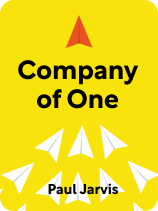
When is business growth your enemy and not your friend? What priorities are more important than growth?
Fast and endless growth isn’t always the best goal for a business. That’s the view of Paul Jarvis, who argues against this common ethos found in the business world. He describes three disadvantages of business growth, especially rapid growth, in his book Company of One.
Continue reading to learn why growth-focused companies don’t always succeed.
Reason #1: Growth Increases Complications
According to Jarvis, one disadvantage of business growth is the inevitable complications it brings. When traditional companies grow and scale, they have to spend more money and hire more employees. This requires a more robust infrastructure, so these companies must invest in new systems that further complicate and slow down work processes.
For example, video game company Zynga spent $100 million on building their own data centers after achieving success with their free game downloads. This became a financial burden for the company as they struggled to keep up with innovations in the video game industry, eventually forcing them to lay off a large number of employees and close the data centers.
If you’re the owner of a company that’s constantly growing, you’ll likely spend more time managing the increasingly complex infrastructure than on the core work—creating or designing a product or service. That core work is the reason you wanted to start the business—a reason that’s unrelated to money. So managing growth takes you away from your original purpose.
Example: Losing Sight of the Core Work
Let’s look at an example of how managing a large company might prevent you from focusing on the core work. Say you run a business that offers book therapy: curated selections of books based on the users’ current mental health needs. Initially, you personally read each user’s profile and create their book selection. This is the core work, and it serves your original purpose for starting the business: to improve people’s lives using the psychological and emotional benefits of reading.
However, as the business grows, you have to hire employees to take on some of this work, and now you spend more time managing them along with the greater vision and day-to-day operations of the company. You spend less time selecting books and communicating with customers. As interest in your service keeps increasing, you develop an algorithm that automatically creates book selections based on customer needs, eliminating personalized, human involvement. Eventually, you spend all your time on tasks that are unrelated to the core work of book curation and the original purpose of helping people. Instead, you’re primarily focused on keeping the company going and increasing profits every year.
Reason #2: Fast Growth Often Leads to Quick Failure
Jarvis argues that, in addition to experiencing the complications of all large companies, companies that attempt to grow substantially in a short time (such as startups) often fail. This is because they spend money they don’t have to facilitate growth. Owners are motivated by the traditional business ethos that success means scaling up and making as much money as possible. So, they spend based on projected revenue instead of their actual revenue, thinking that they’ll recoup it soon enough to keep spending and growing.
When a company spends money based on projections instead of current revenue, it’s a gamble. If their upfront spending pays off, then they have a large, successful company that they can continue to expand or sell. However, if their revenue projections don’t match the actual revenue (which is statistically the more likely scenario), they’re unable to recoup what they spent, and the company collapses. When a high-growth company fails, huge layoffs usually follow, and the company often sells for well below its market value.
For example, Australian startup Shoes of Prey tried to scale by expanding beyond its original model as a web-based custom shoe design service by opening physical stores in malls across the world. With an influx of venture capital funds, the owners spent huge amounts of money, moved to the United States, and hired a lot of new staff to get the project going. However, their sales from the physical stores didn’t match projections, so the company couldn’t generate a return on its investments. This resulted in massive layoffs and its collapse in 2018.
Reason #3: Fast Growth May Harm Your Original Customers
Finally, Jarvis states that fast growth often leads you to make compromises that can harm your relationships with your original customers. Rapid growth typically requires outside investors, which means you have to answer to people beyond yourself and your customers. Investors want returns on their investments, so they bring their own opinions and agendas to the company, some of which may not align with its original mission and goals. If you have investors who don’t support your company’s purpose, you may have to make changes that please them but also alienate your core customer base.
For example, say your company offers prerecorded online cooking classes. From the beginning, you’ve been dedicated to keeping the videos ad-free, and many customers choose your classes because of this feature. However, you bring on some investors who want the company to grow quickly, so they push you to include ads that bring in more revenue. You finally give in, which pleases your investors. It also damages your relationship with your customers since you went back on your original promise, leading to losses in subscribers.

———End of Preview———
Like what you just read? Read the rest of the world's best book summary and analysis of Paul Jarvis's "Company of One" at Shortform.
Here's what you'll find in our full Company of One summary:
- Why growth-focused companies don't always work
- Why single-person companies often excel in quality and service
- Tips on how to get started with your own single-person company





